
KwaZulu-Natal is a province of South Africa that was created in 1994 when the Zulu bantustan of KwaZulu and Natal Province were merged. It is located in the southeast of the country, with a long shoreline on the Indian Ocean and sharing borders with three other provinces and the countries of Mozambique, Eswatini and Lesotho. Its capital is Pietermaritzburg, and its largest city is Durban. It is the second-most populous province in South Africa, with slightly fewer residents than Gauteng.

Bradypodion is a genus of chameleons in the family Chamaeleonidae, collectively called South African dwarf chameleons. All species are found in South Africa and most are endemic to this country, but a few can also be found in Eswatini, Lesotho, southernmost Namibia and possibly southernmost Mozambique. They are quite small chameleons where the different species often can be difficult to separate by appearance, although exact location and the intense breeding colours of males are useful for their identification. They are arboreal, but some species are mostly found low in the vegetation.
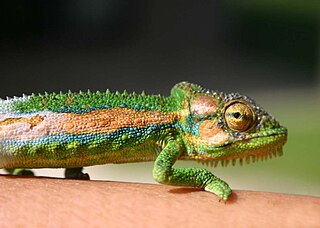
The Cape dwarf chameleon is a chameleon native to the South African province of the Western Cape, where it is restricted to the region around Cape Town.

Currently, two species are placed in the recently established genus Nadzikambia. They are plesiomorphic, small chameleons from the Ruo Gorge forest on Mount Mulanje in Malawi and Mount Mabu in Mozambique.
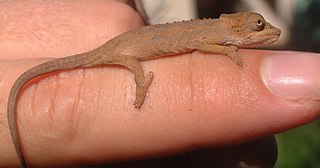
Setaro's dwarf chameleon is a species of lizard in the family Chamaeleonidae.

Smith's dwarf chameleon, also known as the Elandsberg dwarf chameleon, is a species of lizard in the family Chamaeleonidae endemic to Fynbos in South Africa's Eastern Cape. As in several species of chameleons in the genus Bradypodion, the Smith's dwarf chameleon can use its color-changing ability to actively camouflage itself depending on the vision of the specific predator species by which it is being threatened.

The Transvaal dwarf chameleon is a chameleon native to South Africa, where it is found in forested areas of Mpumalanga and Limpopo provinces. It is also known as the Wolkberg dwarf chameleon, after the Wolkberg range.

The Robertson dwarf chameleon, also known as the Little Karoo dwarf chameleon, is a chameleon in the genus Bradypodion. It is found in the dry Fynbos and Renosterveld shrub vegetation, in the centre of the Western Cape province, South Africa.
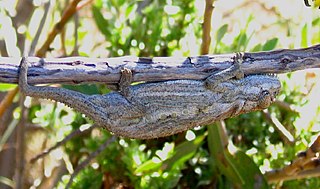
The Swartberg dwarf chameleon is a species of chameleon endemic to South Africa.
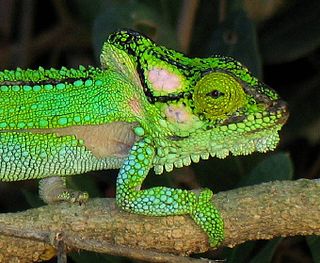
The Knysna dwarf chameleon is a species of dwarf chameleon in the Bradypodion genus that is endemic to South Africa. It is a forest dweller, found only in a limited range in the afromontane forests near Knysna, South Africa, and in certain surrounding areas.
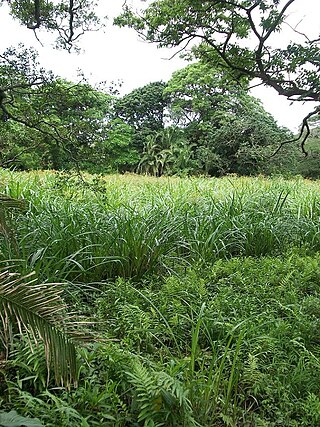
Ilanda Wilds is a nature reserve along Amanzimtoti River in the town of Amanzimtoti, KwaZulu-Natal, South Africa. This small area of land contains various habitat types, ranging from steep rocky slopes to various riverine habitats, forest and small patches of grassland.

The black-headed dwarf chameleon is a lizard of the family Chamaeleonidae endemic to KwaZulu-Natal, South Africa. It is also known as the KwaZulu dwarf chamaeleon and Durban dwarf chameleon.

Areas of forest which grow in KwaZulu-Natal, South Africa mostly on south facing slopes in higher rainfall areas, and along the humid coastal areas. Different types of forest can be identified by their species composition which depends mostly on the altitude, latitude and substrate in which they grow. South facing slopes are favourable for the development of forest as they are more shaded, and therefore cooler and retain more moisture than the northern slopes. The extra moisture on the south slopes is not only favoured by forest trees, but also helps to prevent or subdue wildfires. Fires can also be blocked by cliff faces and rocks or boulders on these slopes, and by streams or rivers at the base of the slopes. The coastal regions are conducive to forest formation, because of high rainfall and humidity which are favoured by forest trees and also help to prevent or subdue fires. The rivers of the coastal areas are also broader than further inland, which may often prevent fires from spreading long distances, and fires generally burn uphill and therefore more often away from areas at low altitude.

oNgoye Forest, also known as Ngoye or Ngoya Forest, is an ancient coastal scarp forest, protected by the oNgoye Forest Reserve in South Africa's KwaZulu-Natal province. The forest of almost 4,000 ha covers an extensive granite ridge that rises from 200 to 460 metres above sea level. It is found some 10 km inland, or 16 km by road, from the coastal town of Mtunzini, and adjoins smaller forest reserves on its periphery, namely Impeshulu in the west, Ezigwayini in the north, and Dengweni in the south.

Bradypodion ventrale, the southern dwarf chameleon, occurs in the Eastern Cape, South Africa. It is also known as the eastern Cape dwarf chameleon. It is a relatively large species of dwarf chameleon, reaching lengths of 14 cm (5.5 in). It has a very prominent casque on the back of its head and a long, beard-like throat crest. It lives in dense thickets and shrub, and is usually very difficult to spot because of its colouring. It adapts very well to living in suburban gardens, but domestic cats – being introduced predators – will usually kill all chameleons in the immediate area. Consequently, one should not bring chameleons into a garden which is frequented by cats. It gives birth to litters of between 10 and 20 babies in the summer.

The Drakensberg dwarf chameleon occurs in the Drakensberg, South Africa, between the latitudes of 27°45′ and 29°15′. Bright green dwarf chameleons found in the Drakensberg south of 29°15′ are now known to be more closely related to the Natal Midlands dwarf chameleon and may yet be described as a separate species.
Ngome Forest is situated to the east of Vryheid, KwaZulu-Natal, South Africa. This is a unique forest, being transitional between Mistbelt Forest and Coastal Scarp Forest. The area has been protected since 1905, and forms part of the Ntendeka Wilderness Area.

The Karkloof Forest is situated in the Karkloof Nature Reserve, 22 km north of Howick, KwaZulu-Natal, South Africa.
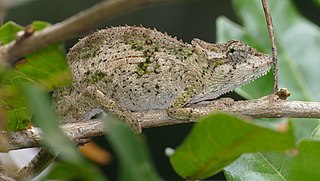
Bradypodion caeruleogula, the Dhlinza dwarf chameleon, Eshowe dwarf chameleon, or uMlalazi dwarf chameleon, is endemic to KwaZulu-Natal, South Africa. It is found in Dhlinza, Entumeni and Ongoye Forests.

The Mlanje Mountain chameleon is one of two species in the genus Nadzikambia. It is a plesiomorphic, small chameleon from the Ruo Gorge forest on Mount Mulanje in Malawi.





















